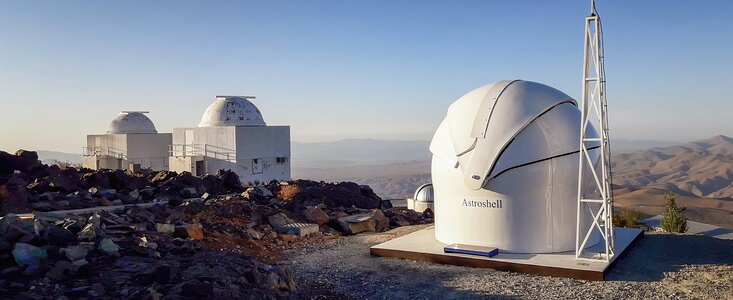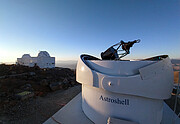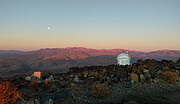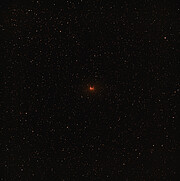Press Release
New telescope at ESO’s La Silla joins effort to protect Earth from risky asteroids
27 April 2021
Part of the world-wide effort to scan and identify near-Earth objects, the European Space Agency’s Test-Bed Telescope 2 (TBT2), a technology demonstrator hosted at ESO’s La Silla Observatory in Chile, has now started operating. Working alongside its northern-hemisphere partner telescope, TBT2 will keep a close eye on the sky for asteroids that could pose a risk to Earth, testing hardware and software for a future telescope network.
“To be able to calculate the risk posed by potentially hazardous objects in the Solar System, we first need a census of these objects. The TBT project is a step in that direction,” says Ivo Saviane, the site manager for ESO’s La Silla Observatory in Chile.
The project, which is a collaboration between the European Southern Observatory (ESO) and the European Space Agency (ESA), “is a test-bed to demonstrate the capabilities needed to detect and follow-up near-Earth objects with the same telescope system,” says ESA’s Head of the Optical Technologies Section Clemens Heese, who is leading this project.
The 56-cm telescope at ESO’s La Silla and TBT1, its identical counterpart located at the ESA’s deep-space ground station at Cebreros in Spain, will act as precursors to the planned ‘Flyeye’ telescope network, a separate project that ESA is developing to survey and track fast-moving objects in the sky. This future network will be entirely robotic; software will perform real-time scheduling of observations and, at the end of the day, it will report the positions and other information about the objects detected. The TBT project is designed to show that the software and hardware work as expected.
“The start of observations of TBT2 at La Silla will enable the observing system to work in its intended two-telescope configuration, finally fulfilling the project’s objectives,” says Heese.
While seriously harmful asteroid impacts on Earth are extremely rare, they are not inconceivable. The Earth has been periodically bombarded with both large and small asteroids for billions of years, and the 2013 Chelyabinsk meteor event, which caused some 1600 injuries, most due to flying splinters and broken glass, further raised the public’s awareness of the threat posed by near-Earth objects. Larger objects do more damage, but are thankfully easier to spot and the orbits of known large asteroids are already thoroughly studied. However, it is estimated that there are large numbers of smaller, yet-undiscovered objects we are unaware of that could do serious damage if they were to hit a populated area.
That’s where TBT and the future planned network of Flyeye telescopes come in. Once fully operational the network’s design would allow it to survey the night sky to track fast-moving objects, a significant advancement in Europe’s capacity to spot potentially hazardous near-Earth objects.
TBT is part of an ongoing inter-organisational effort to build a more complete picture of these objects and the potential risks they pose. This project builds on ESO’s previous involvement in protecting the Earth from potentially dangerous near-Earth objects. Both ESO and ESA are active in the United Nations-endorsed International Asteroid Warning Network and many observations of these objects have been performed with ESO’s telescopes. ESO’s New Technology Telescope at La Silla, for example, has been used for observations of small near-Earth asteroids in support of the European NEOShield-2 project.
The ongoing inter-organisational collaboration between ESO and ESA is particularly significant in the study of near-Earth objects. While TBT is the first telescope project to be realised under a cooperation agreement between the two organisations, ESO has been helping ESA track potentially dangerous objects since 2014, by using its Very Large Telescope at Paranal Observatory to observe very faint objects. These efforts combined are a significant leap forward for the worldwide search and management of asteroids, and have already proved useful in ruling out collisions of asteroids with the Earth.
The installation and first light of TBT2 at ESO’s La Silla Observatory was achieved under strict health and safety conditions. ESO's observatories temporarily stopped operations last year due to the COVID-19 pandemic, but have since resumed science observations under restrictions that ensure the safety and protection of everyone at the sites.
More information
ESO is the foremost intergovernmental astronomy organisation in Europe and the world’s most productive ground-based astronomical observatory by far. It has 16 Member States: Austria, Belgium, Czechia, Denmark, France, Finland, Germany, Ireland, Italy, the Netherlands, Poland, Portugal, Spain, Sweden, Switzerland and the United Kingdom, along with the host state of Chile and with Australia as a Strategic Partner. ESO carries out an ambitious programme focused on the design, construction and operation of powerful ground-based observing facilities enabling astronomers to make important scientific discoveries. ESO also plays a leading role in promoting and organising cooperation in astronomical research. ESO operates three unique world-class observing sites in Chile: La Silla, Paranal and Chajnantor. At Paranal, ESO operates the Very Large Telescope and its world-leading Very Large Telescope Interferometer as well as two survey telescopes, VISTA working in the infrared and the visible-light VLT Survey Telescope. Also at Paranal ESO will host and operate the Cherenkov Telescope Array South, the world’s largest and most sensitive gamma-ray observatory. ESO is also a major partner in two facilities on Chajnantor, APEX and ALMA, the largest astronomical project in existence. And on Cerro Armazones, close to Paranal, ESO is building the 39-metre Extremely Large Telescope, the ELT, which will become “the world’s biggest eye on the sky”.
The European Space Agency (ESA) provides Europe’s gateway to space. ESA is an intergovernmental organisation, created in 1975, with the mission to shape the development of Europe’s space capability and ensure that investment in space delivers benefits to the citizens of Europe and the world. ESA has 22 Member States: Austria, Belgium, Czechia, Denmark, Estonia, Finland, France, Germany, Greece, Hungary, Ireland, Italy, Luxembourg, the Netherlands, Norway, Poland, Portugal, Romania, Spain, Sweden, Switzerland and the United Kingdom. Slovenia is an Associate Member. ESA has established formal cooperation with seven Member States of the EU. Canada takes part in some ESA programmes under a Cooperation Agreement. By coordinating the financial and intellectual resources of its members, ESA can undertake programmes and activities far beyond the scope of any single European country. It is working in particular with the EU on implementing the Galileo and Copernicus programmes as well as with Eumetsat for the development of meteorological missions. ESA develops the launchers, spacecraft and ground facilities needed to keep Europe at the forefront of global space activities. Today, it develops and launches satellites for Earth observation, navigation, telecommunications and astronomy, sends probes to the far reaches of the Solar System and cooperates in the human exploration of space. ESA also has a strong applications programme developing services in Earth observation, navigation and telecommunications.
Links
Contacts
Bárbara Ferreira
ESO Media Manager
Garching bei München, Germany
Cell: +49 151 241 664 00
Email: press@eso.org
ESA Newsroom & Media Relations Office
Email: media@esa.int
About the Release
| Release No.: | eso2107 |
| Name: | Test-Bed Telescope |
| Type: | Unspecified : Technology : Observatory : Telescope |
| Facility: | Test-Bed Telescope |
Our use of Cookies
We use cookies that are essential for accessing our websites and using our services. We also use cookies to analyse, measure and improve our websites’ performance, to enable content sharing via social media and to display media content hosted on third-party platforms.
ESO Cookies Policy
The European Organisation for Astronomical Research in the Southern Hemisphere (ESO) is the pre-eminent intergovernmental science and technology organisation in astronomy. It carries out an ambitious programme focused on the design, construction and operation of powerful ground-based observing facilities for astronomy.
This Cookies Policy is intended to provide clarity by outlining the cookies used on the ESO public websites, their functions, the options you have for controlling them, and the ways you can contact us for additional details.
What are cookies?
Cookies are small pieces of data stored on your device by websites you visit. They serve various purposes, such as remembering login credentials and preferences and enhance your browsing experience.
Categories of cookies we use
Essential cookies (always active): These cookies are strictly necessary for the proper functioning of our website. Without these cookies, the website cannot operate correctly, and certain services, such as logging in or accessing secure areas, may not be available; because they are essential for the website’s operation, they cannot be disabled.
Functional Cookies: These cookies enhance your browsing experience by enabling additional features and personalization, such as remembering your preferences and settings. While not strictly necessary for the website to function, they improve usability and convenience; these cookies are only placed if you provide your consent.
Analytics cookies: These cookies collect information about how visitors interact with our website, such as which pages are visited most often and how users navigate the site. This data helps us improve website performance, optimize content, and enhance the user experience; these cookies are only placed if you provide your consent. We use the following analytics cookies.
Matomo Cookies:
This website uses Matomo (formerly Piwik), an open source software which enables the statistical analysis of website visits. Matomo uses cookies (text files) which are saved on your computer and which allow us to analyze how you use our website. The website user information generated by the cookies will only be saved on the servers of our IT Department. We use this information to analyze www.eso.org visits and to prepare reports on website activities. These data will not be disclosed to third parties.
On behalf of ESO, Matomo will use this information for the purpose of evaluating your use of the website, compiling reports on website activity and providing other services relating to website activity and internet usage.
Matomo cookies settings:
Additional Third-party cookies on ESO websites: some of our pages display content from external providers, e.g. YouTube.
Such third-party services are outside of ESO control and may, at any time, change their terms of service, use of cookies, etc.
YouTube: Some videos on the ESO website are embedded from ESO’s official YouTube channel. We have enabled YouTube’s privacy-enhanced mode, meaning that no cookies are set unless the user actively clicks on the video to play it. Additionally, in this mode, YouTube does not store any personally identifiable cookie data for embedded video playbacks. For more details, please refer to YouTube’s embedding videos information page.
Cookies can also be classified based on the following elements.
Regarding the domain, there are:
- First-party cookies, set by the website you are currently visiting. They are stored by the same domain that you are browsing and are used to enhance your experience on that site;
- Third-party cookies, set by a domain other than the one you are currently visiting.
As for their duration, cookies can be:
- Browser-session cookies, which are deleted when the user closes the browser;
- Stored cookies, which stay on the user's device for a predetermined period of time.
How to manage cookies
Cookie settings: You can modify your cookie choices for the ESO webpages at any time by clicking on the link Cookie settings at the bottom of any page.
In your browser: If you wish to delete cookies or instruct your browser to delete or block cookies by default, please visit the help pages of your browser:
Please be aware that if you delete or decline cookies, certain functionalities of our website may be not be available and your browsing experience may be affected.
You can set most browsers to prevent any cookies being placed on your device, but you may then have to manually adjust some preferences every time you visit a site/page. And some services and functionalities may not work properly at all (e.g. profile logging-in, shop check out).
Updates to the ESO Cookies Policy
The ESO Cookies Policy may be subject to future updates, which will be made available on this page.
Additional information
For any queries related to cookies, please contact: pdprATesoDOTorg.
As ESO public webpages are managed by our Department of Communication, your questions will be dealt with the support of the said Department.













